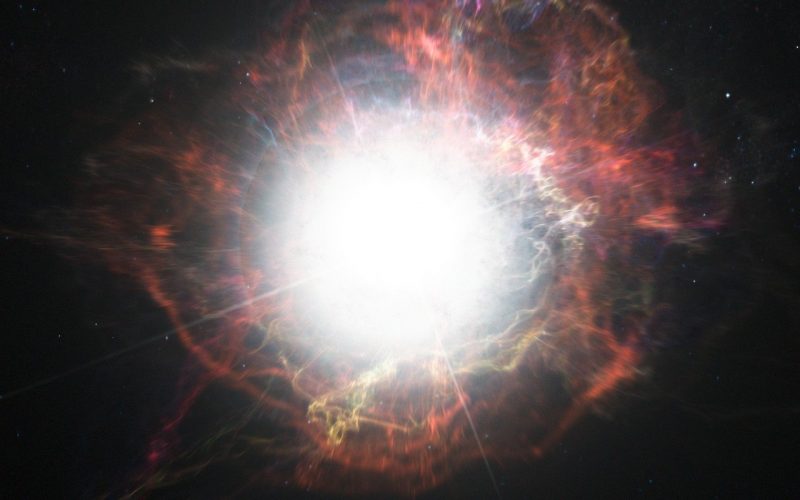
Space might seem unchanging as you stand on Earth looking up at the inky blackness, but it isn’t, always. Indeed, the stillness can be punctuated at times by immense explosions, such as when stars go supernova in brilliant bursts of light. Supernovae are common, relatively speaking. But now scientists have observed a new type of explosion in space, and so far they don’t have an explanation for it. A science team reported the explosion on June 17, 2018, in The Astronomer’s Telegram, which is an internet-based publication service for disseminating new astronomical information quickly. The discovery team then discussed the explosion in a June 22 article in the popular weekly science magazine New Scientist. They said they saw the immense flash coming to us from another galaxy, 200 million light-years away. And, they said, this flash must have been 10 to 100 times brighter than a typical supernova.
The mysterious flash has been nicknamed The Cow by astronomers since it was listed as AT2018cow in a database, thanks to the randomized three-letter naming system.
The asteroid-tracking ATLAS telescopes in Hawaii were the first to see the mystery explosion. At first, astronomers thought it originated in our own galaxy. They thought it might be what’s called a cataclysmic variable star, typically two stars orbiting one another and interacting in a way that increases the whole system’s brightness irregularly. But subsequent spectroscopic observations showed the explosion came from another galaxy – labeled CGCG 137-068 – located some 200 million light-years away in the direction of the constellation Hercules.
As astronomer Kate Maguire of Queen’s University Belfast noted simply to New Scientist:
It really just appeared out of nowhere.

Indeed, and it certainly took astronomers by surprise. But apart from the brightness, the most unusual aspect of the explosion was its speed, reaching peak brightness in just two days; most supernovae take weeks to do that. As Maguire also noted:
There are other objects that have been discovered that are as fast, but the fastness and the brightness, that’s quite unusual. There hasn’t really been another object like this.
Stephen Smartt, an astrophysicist at Queen’s University Belfast and a lead scientist for the ATLAS survey, commented to the Washington Post on June 25 that:
I’ve never seen anything like this before in the local universe.
As to what caused this intense blast, scientists don’t know yet, but they say that it is composed of a 16,000 degree Fahrenheit (9,000 degree Celsius) cloud of high-energy particles, expanding outward at 12,000 miles (20,000 kilometers) per second. It is also very bright in all parts of the electromagnetic spectrum, and its spectrum is also “surprisingly smooth,” unlike most supernovae which have distinct absorption lines. According to Smartt:
No one has successfully matched them yet to the known features we normally see in supernova.

After the flash was reported to The Astronomer’s Telegram, astronomy teams used at least 18 telescopes from around the world to study the occurrence. According to Robert Rutledge, editor-in-chief of The Astronomer’s Telegram and an astrophysicist at McGill University in Canada:
I think it’s the most notices for any individual object in such a short period of time. It has produced a lot of interest.
But if the flash isn’t a typical supernova, then what is it? As Maguire noted:
We’re not sure yet what it is, but the normal powering mechanism for a supernova is radioactive decay of nickel, and this event is too bright and too fast for that.
It could be a type 1c supernova, where the core has collapsed in a massive star that has already lost its outer veil of hydrogen and helium, but only further observations will help to determine that, or rule it out as an explanation. Astronomers will continue to study this fascinating mystery, even though the blast has already started to fade now.

Bottom line: Astronomers have another fascinating mystery on their hands, as they try to figure out the nature of a huge, unusual explosion – labeled AT2018cow, nicknamed The Cow by astronomers – in a distant galaxy. Is it a type of supernova, or something more exotic?
Via The Astronomer’s Telegram, New Scientist and the Washington Post.
Help EarthSky keep going! Please donate what you can to our annual crowd-funding campaign.











